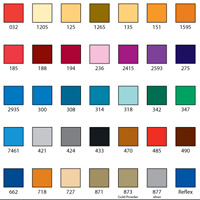
Color printing is the reproduction of an image or text (or both) in color, rather than in black and white.
Of course, it is not that simple. There are different techniques used to reproduce color images and text. This article will discuss two of these methods and which process to use when.
Four-color process
The four-color process is used to print items that have a full spectrum of colors, such as a color photograph. The four colors include three primary colors – cyan, magenta and yellow, along with black (known as CMYK for short). Another full-color printing method, the six-color process, is newer and adds orange and green to the CMYK palette, which provides a bigger and brighter color range. The colors produced are known as process colors.
Spot-color process
Whereas the four-color process mixes four colors together in different combinations to produce different colors, spot color ink is used alone, rather than mixed, to make various colors. Spot color ink can be used in combination with four-color inks if needed.
Spot color inks are nearly unlimited in color range and can be more varied than the color produced by the four-color process. Spot color inks can print colors from pastels to metallics and other finishes. The colors produced are known as spot colors.
Spot color printing is generally cheaper to produce than process color printing, but spot colors are not appropriate for any material that includes a photo or a wide range of colors.
So how do you know which process to use when?
Use process colors if:
– you are using full color photos
– you need more than two spot colors (otherwise, your spot color printing cost could get more expensive than process color printing)
– your document includes many different graphics with many shades of color
Use spot colors if:
– you have no full color photos – your photos only include one spot color and black
– you repeatedly need a color that CMYK can’t produce properly (for instance, if your logo is to be printed over and over)
– you need colors that are more vibrant
– you want to use metallic or fluorescent colors
– you have a large printing area, such as a poster (spot colors cover well than process colors)
In addition, sometimes you need to use spot colors and process colors together, such as when:
– your document has full-color photographs and you have your logo on the page, which includes a color that cannot be properly produced by CMYK
– you need to increase the intensity of a process color – adding a spot color ink will deepen the process color
– your full color publication is coated with varnish, and varnish is designated as a spot color.
To help you get started, please visit one of our full service color printers below or to the right:
About the Author
Kaye Z. Marks is an avid writer and follower of developments in color printing industry and how these improvements can benefit small to medium-scale business.

